 Later this week, I’ll be doing some volunteering as part the Starbucks Global Month of Service. I found myself in need of a new green Starbucks “community service” t-shirt and so after some emails and coordinating, I scheduled a time to pick one up at the Starbucks headquarters. I dropped by the SSC (the Starbucks headquarters is called the “SSC,” which stands for the Starbucks Support Center) at 8:00 AM. In fact, I arrived early.
Later this week, I’ll be doing some volunteering as part the Starbucks Global Month of Service. I found myself in need of a new green Starbucks “community service” t-shirt and so after some emails and coordinating, I scheduled a time to pick one up at the Starbucks headquarters. I dropped by the SSC (the Starbucks headquarters is called the “SSC,” which stands for the Starbucks Support Center) at 8:00 AM. In fact, I arrived early.
I sat in the lobby of the waiting area of the 8th floor for about fifteen minutes. As people poured from the elevators into the building, I occasionally waved and said hello to passersby whom I’d met before.
In 2011, Starbucks painted the walls of their lobby area with their business development timeline. It tells the story of a small company that sold just coffee beans in 1971 to global enterprise operating all over the world. This morning, as waited, I carefully looked at the timeline, as I have done many times before. You have to know where you came from, to know where you’re going, I thought. You might enjoy the timeline too:
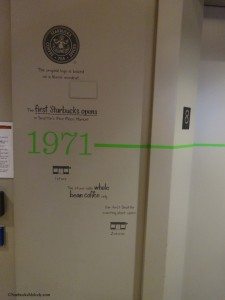 ^ In 1972, Starbucks operated two stores: One at the edge of the Market and the other in Seattle’s University Village shopping area.
^ In 1972, Starbucks operated two stores: One at the edge of the Market and the other in Seattle’s University Village shopping area.
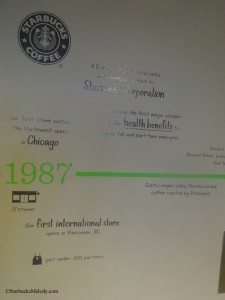 In October 1987, Starbucks opens its first store in Chicago. That logo featured in the 1987 panel is the logo that first introduced me to Starbucks, when I moved to Seattle in 1989.
In October 1987, Starbucks opens its first store in Chicago. That logo featured in the 1987 panel is the logo that first introduced me to Starbucks, when I moved to Seattle in 1989.
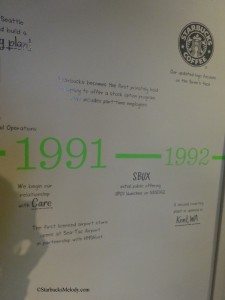 In June 1992, Starbucks became a publicly traded corporation and the logo went through a redesign, removing her lower half below her belly button.
In June 1992, Starbucks became a publicly traded corporation and the logo went through a redesign, removing her lower half below her belly button.
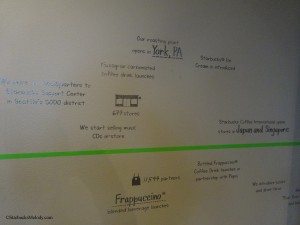 ^ The 1990s were an era of fast-paced evolution for Starbucks. I know that some people found the Onward era of change jarring, but the 1990s were incredible. From the customer perspective, I saw Starbucks introduce coffee Frappuccinos into stores, begin selling whole bean coffee in grocery stores, expand merchandise offerings, the “short” size dropped of the menu and the Venti size was introduced.
^ The 1990s were an era of fast-paced evolution for Starbucks. I know that some people found the Onward era of change jarring, but the 1990s were incredible. From the customer perspective, I saw Starbucks introduce coffee Frappuccinos into stores, begin selling whole bean coffee in grocery stores, expand merchandise offerings, the “short” size dropped of the menu and the Venti size was introduced.
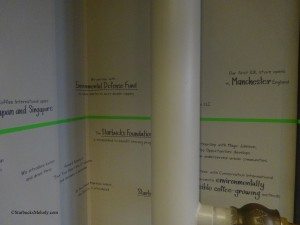 ^ 1998, famed basketball player Magic Johnson formed a 50/50 enterprise with Starbucks to operate a little over 100 stores in under-served, urban locations. That venture dissolved in 2010, with Starbucks acquiring the full business interest in those “urban coffee opportunity” stores.
^ 1998, famed basketball player Magic Johnson formed a 50/50 enterprise with Starbucks to operate a little over 100 stores in under-served, urban locations. That venture dissolved in 2010, with Starbucks acquiring the full business interest in those “urban coffee opportunity” stores.
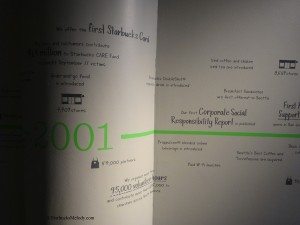 ^ In 2001, Starbucks introduced the first Starbucks card. By the early 2000s, there were about 54,000 partners and 8,000 stores.
^ In 2001, Starbucks introduced the first Starbucks card. By the early 2000s, there were about 54,000 partners and 8,000 stores.
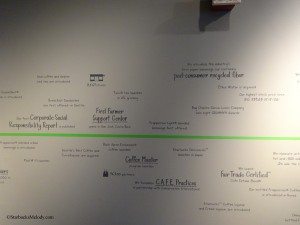 ^ In 2003, Starbucks formalized its CAFE practices standards, which is a score card system, grading coffee farms on their treatment of the environment, the condition of their farm, transparency of business operations, and much more. Together, Conservation International and Starbucks developed the CAFE practices system.
^ In 2003, Starbucks formalized its CAFE practices standards, which is a score card system, grading coffee farms on their treatment of the environment, the condition of their farm, transparency of business operations, and much more. Together, Conservation International and Starbucks developed the CAFE practices system.
And it ends with the word Onward.
Related posts
3 Comments
Leave a Reply Cancel reply
You must be logged in to post a comment.
Sponsors
Recent Comments
- DEVIN on Compostable Straws Land in Seattle Starbucks Stores
- coffeebeanz on Why do you go to Starbucks less often? (If that’s true for you)
- Willi on You can now buy a Siren statue: $6,000
- Willi on A major revamp of your drink recipe: Testing syrup extracts and cane sugar
- Skip on Why do you go to Starbucks less often? (If that’s true for you)



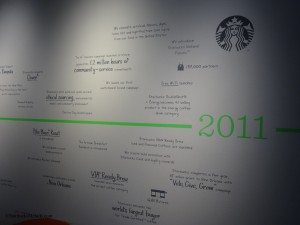



Great message, Melody! I love seeing your pictures and posts from headquarters. I really hope to save up for the trip to make it out there some day (maybe we can meet up for coffee)! In my Coffee Master training, the very first module is about the history of coffee and of Starbucks- it’s my absolute favorite part of the training. I love that this company references its roots, often and loudly, as a part of its passion for coffee and community. Inspiring the human spirit since 1971!
You know it might be interesting for SB to develop this timeline on a smaller scale to place in the stores!
@Ness – I hope we do meet for coffee one day!
@Purple1 – Love that idea!